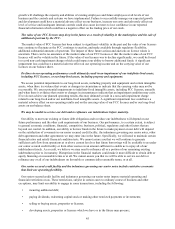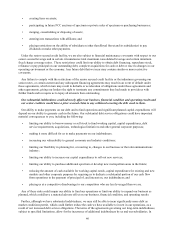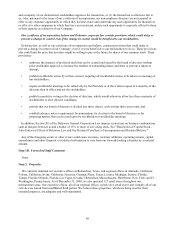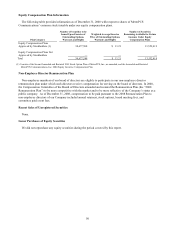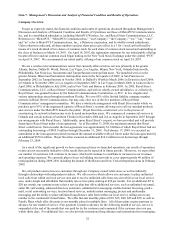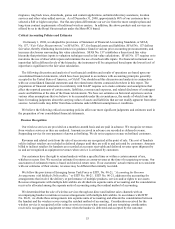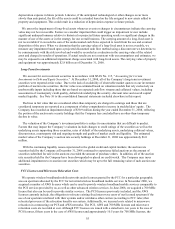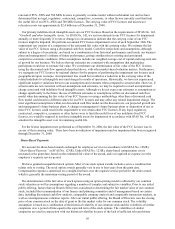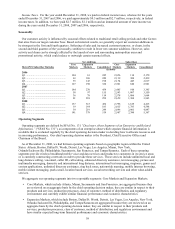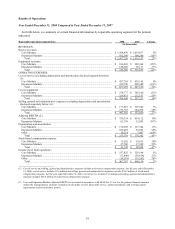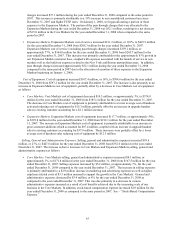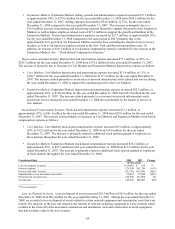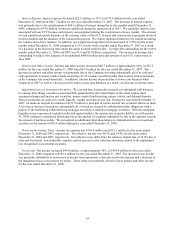Metro PCS 2008 Annual Report Download - page 64
Download and view the complete annual report
Please find page 64 of the 2008 Metro PCS annual report below. You can navigate through the pages in the report by either clicking on the pages listed below, or by using the keyword search tool below to find specific information within the annual report.55
depreciation expense in future periods. Likewise, if the anticipated technological or other changes occur more
slowly than anticipated, the life of the assets could be extended based on the life assigned to new assets added to
property and equipment. This could result in a reduction of depreciation expense in future periods.
We assess the impairment of long-lived assets whenever events or changes in circumstances indicate the carrying
value may not be recoverable. Factors we consider important that could trigger an impairment review include
significant underperformance relative to historical or projected future operating results or significant changes in the
manner of use of the assets or in the strategy for our overall business. The carrying amount of a long-lived asset is
not recoverable if it exceeds the sum of the undiscounted cash flows expected to result from the use and eventual
disposition of the asset. When we determine that the carrying value of a long-lived asset is not recoverable, we
measure any impairment based upon a projected discounted cash flow method using a discount rate we determine to
be commensurate with the risk involved and would be recorded as a reduction in the carrying value of the related
asset and charged to results of operations. If actual results are not consistent with our assumptions and estimates, we
may be exposed to an additional impairment charge associated with long-lived assets. The carrying value of property
and equipment was approximately $2.8 billion as of December 31, 2008.
Long-Term Investments
We account for our investment securities in accordance with SFAS No. 115, “Accounting for Certain
Investments in Debt and Equity Securities.” At December 31, 2008, all of the Company’s long-term investment
securities were reported at fair value. Due to the lack of availability of observable market quotes on our investment
portfolio of auction rate securities, the fair value was estimated based on valuation models that rely exclusively on
unobservable inputs including those that are based on expected cash flow streams and collateral values, including
assessments of counterparty credit quality, default risk underlying the security, discount rates and overall capital
market liquidity. See Note 10 to the consolidated financial statements included elsewhere in this report.
Declines in fair value that are considered other-than-temporary are charged to earnings and those that are
considered temporary are reported as a component of other comprehensive income in stockholders’ equity. The
Company has recorded an impairment charge of $30.9 million during the year ended December 31, 2008, reflecting
the portion of the auction rate security holdings that the Company has concluded have an other-than-temporary
decline in value.
The valuation of the Company’s investment portfolio is subject to uncertainties that are difficult to predict.
Factors that may impact the Company’s valuation include changes to credit ratings of the securities as well as the
underlying assets supporting those securities, rates of default of the underlying assets, underlying collateral values,
discount rates, counterparty risk and ongoing strength and quality of market credit and liquidity. The estimated
market value of the Company’s auction rate security holdings at December 31, 2008 was approximately $6.0
million.
With the continuing liquidity issues experienced in the global credit and capital markets, the auction rate
securities held by the Company at December 31, 2008 continued to experience failed auctions as the amount of
securities submitted for sale in the auctions exceeded the amount of purchase orders. In addition, all of the auction
rate securities held by the Company have been downgraded or placed on credit watch. The Company may incur
additional impairments to its auction rate securities which may be up to the full remaining value of such auction rate
securities.
FCC Licenses and Microwave Relocation Costs
We operate wireless broadband mobile networks under licenses granted by the FCC for a particular geographic
area on spectrum allocated by the FCC for terrestrial wireless broadband mobile services. In November 2006, we
acquired a number of AWS licenses which can be used to provide wireless broadband mobile services comparable to
the PCS services provided by us, as well as other advanced wireless services. In June 2008, we acquired a 700 MHz
license that also can be used to provide similar services. The PCS licenses previously included, and the AWS
licenses currently include, the obligation to relocate existing fixed microwave users of our licensed spectrum if the
use of our spectrum interfered with their systems and/or reimburse other carriers (according to FCC rules) that
relocated prior users if the relocation benefits our system. Additionally, we incurred costs related to microwave
relocation in constructing our PCS and AWS networks. The PCS, AWS and 700 MHz licenses and microwave
relocation costs are recorded at cost. Although FCC licenses are issued with a stated term, ten years in the case of
PCS licenses, fifteen years in the case of AWS licenses and approximately 10.5 years for 700 MHz licenses, the


